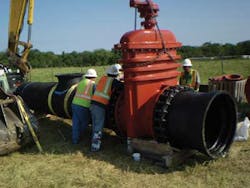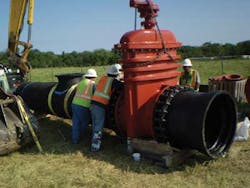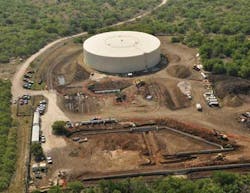GIS-Enabled: Modeling Simplifies Pipeline Route Selection
By Ron Mick and and Kristi Teykl
The implementation of a Geographic Information System (GIS) can have a profound effect on management of large water and wastewater infrastructure assets. A GIS-enabled Suitability Model can be used to aid engineers and analysts in the selection of routes in large linear projects, greatly enhancing quality control while minimizing environmental impact.
This innovative technology was employed by URS on a recent project undertaken on behalf of the City of Austin, TX. The city was called upon to expand its water and wastewater infrastructure in a limited time frame, driven by rapid growth in the southeast area of the city, particularly along and east of IH 35. The city evaluated the existing Austin Water Utility (AWU) Long-Range Master Plan and determined that the best approach was to establish the South IH 35 Water/Wastewater Infrastructure Improvements Program, which would be committed to fast-track design and construction of key water and wastewater infrastructure projects.
The City of Austin brought in URS as Program Management Consultant (PMC) to ensure the South IH-35 Program was successful. URS began with preliminary engineering design of 13 miles of water transmission main, three miles of wastewater interceptor, a 20 mgd pump station, and an elevated storage tank.
Pipeline Route
Determining the route of a pipeline is one of the most critical elements in the development of a linear infrastructure project. The cost and impact of the project are directly related to the quality and success of the routing process. The primary objective is to select a location that is cost-effective, environmentally appropriate, and meets the needs of the project.
Traditionally, potential routes are sketched on paper and a set of criteria is developed for the evaluation of those routes. Criteria generally include environmental hazards, physical barriers, challenging road crossings, a count of affected properties, and the length of the project area.
The handful of probable, or likely, routes are tweaked to avoid critical flaws and evaluated with a scoring matrix. Viable options are selected from a brief desktop study of real estate, rights-of-way, significant environmental features, highway crossings, and length. The potential routes are then evaluated in more detail. The elements of any scoring matrix vary by project and the needs of the owner but some general criteria are cost, environmental impacts, public disruption, number of required easements, and technical challenges. Each route is evaluated objectively and scored. The scores determine the route that best meets the overall needs of the project.
This method of routing evaluation has been employed for as long as water pipelines have been used to transport drinking water to the public. However, advances in technology have improved the evaluation process, and GIS has provided some of the most dramatic changes.
New Approach
GIS specialists and modelers at URS developed a GIS-enabled Suitability Model that was employed in the South IH-35 project. Once constituted, the model does the route analysis based on information provided by the modeler. The process begins with a map of all constraints that comprise the evaluation criteria for route analysis. These evaluation criteria are the same as those used in a traditional route analysis: cost, environmental impacts, public disruption, number of required easements, technical challenges, etc. Each criterion is assigned a suitability value based on a scale of 1 to 9, with 1 being the most suitable and 9 being the least suitable. Each criterion is then weighted based on project requirements, specific concerns, and values of the owner. Some features such as critical habitat or historic resources can be designated as avoidance criteria or "no-go" areas. All suitability criteria are summed to form a suitability surface.
From the suitability surface, an optimal path for the water pipeline is determined by applying an optimal path algorithm. By applying the algorithm, the model takes a stepwise approach between a starting and ending point and it proceeds to calculate the most suitable route between the points by evaluating the criteria from the suitability surface. The optimal path algorithm focuses on minimizing constraints (i.e., crossing streams) and maximizing opportunities (i.e., paralleling property boundaries or existing infrastructure) that were previously defined in the suitability model.
In Austin, the GIS-enabled Suitability Model was used for route evaluation of the South IH-35 Program's 13 miles of water transmission main (WTM). In keeping with a compressed schedule, the PMC employed several techniques to accelerate the work, including subdivision of the WTM into 21 segments for analysis, with those segments eventually regrouped into 17 design projects. To keep the program on schedule, a fully analyzed pipeline route was given to each design firm upon notice to proceed with design. The GIS-enabled Suitability Model was used to define a route for the transmission main in order to provide a consistent methodology for all projects in an efficient and timely manner.
Early on in the process, the PMC began gathering the necessary data to develop the study area base map. At the same time, it conducted aerial surveys as well as windshield tours of the program area to allow engineers and analysts to gain a deeper understanding of the program area that would be modeled. The analysts met regularly with the AWU and the City of Austin staff as well as area developers to determine the needs of each group. Evaluation criteria were established and a cumulative suitability surface was defined upon which the analysts and engineers applied the optimal path algorithm to define the WTM route for the South IH-35 Program.
Path Evaluation
The Suitability Model provides a pipeline alignment that is rough and follows the model input criteria directly. However, the world does not exist in the GIS-created block units of the model. So, it is typical to go through an evaluation of the model route and make minor adjustments. Much of the time, the evaluation reveals minor differences requiring small adjustments in straightening out the route or improving its fit along property and easement boundaries.
For the South IH-35 Program, the typical minor adjustments were made, particularly in one area along IH-35 where the model was seeking to avoid congested areas within a retail development. The design team determined that a route aligned with the South IH-35 right-of-way would better serve the needs of the AWU than a model-generated route away from the right-of-way line.
Versatility of the Model
The GIS-enabled Suitability Model is adaptable to a wide variety of linear projects. It has proven to be effective in improving efficiency in route evaluations and is well suited to large, complex projects - particularly those providing a corridor alignment - that normally would require many weeks of evaluation and several iterations of available routes. The model also is useful for rural environments that are difficult to evaluate visually.
On the IH-35 project, the GIS-enabled Suitability Model provided a significant benefit over traditional ranking matrix evaluations in terms of cost and time efficiency. It allowed for adjustments to criteria to be evaluated quickly and easily by simply adjusting the suitability criteria and re-running optimal path routing.
About the Authors: Ron Mick is a civil engineer and project manager with URS Corporation in Austin. He has extensive experience in the design, construction, and management of water delivery systems, including transmission pipelines, pump stations, well fields, and treatment systems. He is a licensed professional engineer in Texas. Kristi Teykl serves as the Section Leader of the Geospatial Technology and Planning Services practice in the Austin office of URS. She has extensive experience developing and implementing geospatial technology and data and is responsible for conceptualization, technical design, and management of projects with a geospatial component for public and private sector clients.
WaterWorld Articles Archives


